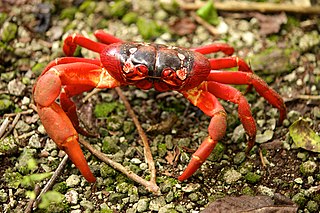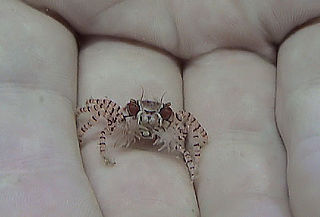
Crabs are decapod crustaceans of the infraorder Brachyura, which typically have a very short projecting "tail" (abdomen), usually hidden entirely under the thorax. They live in all the world's oceans, in fresh water, and on land, are generally covered with a thick exoskeleton, and have a single pair of pincers. Many other animals with similar names – such as hermit crabs, king crabs, porcelain crabs, horseshoe crabs, stone crabs, and crab lice – are not true crabs, but many have evolved features similar to true crabs through a process known as carcinisation.

Hermit crabs are anomuran decapod crustaceans of the superfamily Paguroidea that have adapted to occupy empty scavenged mollusc shells to protect their fragile exoskeletons. There are over 800 species of hermit crab, most of which possess an asymmetric abdomen concealed by a snug-fitting shell. Hermit crabs' non-calcified abdominal exoskeleton makes their exogenous shelter system obligatory. Hermit crabs must occupy shelter produced by other organisms, or risk being defenseless.

A fiddler crab, sometimes known as a calling crab, may be any of more than one hundred species of semiterrestrial marine crabs in the family Ocypodidae. A smaller number of ghost crab and mangrove crab species are also found in the family Ocypodidae. This entire group is composed of small crabs, the largest being slightly over two inches (5 cm) across. Fiddler crabs are found along sea beaches and brackish intertidal mud flats, lagoons and swamps. Fiddler crabs are most well known for their sexually dimorphic claws; the males' major claw is much larger than the minor claw, while the females' claws are both the same size.

The Japanese spider crab is a species of marine crab that lives in the waters around Japan. It has the largest leg span of any arthropod. They go through three main larval stages along with a prezoeal stage in order to grow to their great size. The genus Macrocheira contains multiple species. Two fossil species of this genus have been found, Macrocheira ginzanensis and Macrocheira yabei, both from the Miocene of Japan. The diverse taxonomic history is an important part of what these creatures are and how they evolved to be what they are today. These creatures are not isolated however, as they are the subject of fishery and are considered a delicacy. Conservation efforts are being put forth to protect these creatures and their population from the dangers of overfishing.

The Dungeness crab, Metacarcinus magister or Cancer magister, is a species of crab that inhabits eelgrass beds and water bottoms on the west coast of North America. It typically grows to 20 cm (7.9 in) across the carapace and is a popular seafood. Its common name comes from the port of Dungeness, Washington, United States, where it is "a prized crustacean that supports the most valuable fishery on the west coast", and where ocean acidification threatens the marine environment.

Horseshoe crabs are marine and brackish water arthropods of the family Limulidae, suborder Xiphosurida, and order Xiphosura. Their popular name is a misnomer, as they are not true crabs, nor even crustaceans, as crabs are, but a different order of arthropod.

Chionoecetes is a genus of crabs that live in the northern Pacific and Atlantic Oceans.

Xanthidae is a family of crabs known as gorilla crabs, mud crabs, pebble crabs or rubble crabs. Xanthid crabs are often brightly coloured and are highly poisonous, containing toxins which are not destroyed by cooking and for which no antidote is known. The toxins are similar to the tetrodotoxin and saxitoxin produced by puffer fish, and may be produced by bacteria in the genus Vibrio living in symbiosis with the crabs, mostly V. alginolyticus and V. parahaemolyticus.

The Christmas Island red crab is a species of land crab that is endemic to Christmas Island and Cocos (Keeling) Islands in the Indian Ocean. Although restricted to a relatively small area, an estimated 43.7 million adult red crabs once lived on Christmas Island alone, but the accidental introduction of the yellow crazy ant is believed to have killed about 10–15 million of these in recent years. Christmas Island red crabs make an annual mass migration to the sea to lay their eggs in the ocean. Although its population is under great assault by the ants, as of 2020 the red crab had not been assessed by the International Union for Conservation of Nature (IUCN) and it was not listed on their Red List.

Cancer (♋︎) is the fourth astrological sign in the Zodiac, originating from the constellation of Cancer. It spans from 90° to 120° celestial longitude. Under the tropical zodiac, the Sun transits this area between approximately June 22 and July 22, and under the sidereal zodiac, the Sun transits this area between approximately July 21 and August 9.

Portunus armatus, also known as the flower crab, blue crab, blue swimmer crab, blue manna crab or sand crab, rajungan in Indonesian, and alimasag in Tagalog, Kapampangan, and Pangasinan, is a large crab found in the intertidal estuaries around most of Australia and east to New Caledonia.

Portunidae is a family of crabs which contains the swimming crabs.

The Ocypodidae are a family of semiterrestrial crabs that includes the ghost crabs and fiddler crabs. They are found on tropical and temperate shorelines around the world.

The pie crust crab, is a species of crab found around New Zealand and south-eastern Australia.

Pseudothelphusidae is a family of freshwater crabs found chiefly in mountain streams in the Neotropics. They are believed to have originated in the Greater Antilles and then crossed to Central America via a Pliocene land bridge.

Lybia is a genus of small crabs in the family Xanthidae. Their common names include boxer crabs, boxing crabs and pom-pom crabs. They are notable for their mutualism with sea anemones, which they hold in their claws for defense. In return, the anemones get carried around which may enable them to capture more food particles with their tentacles. Boxer crabs use at least three species of anemones, including Bundeopsis spp. and Triactis producta. The bonding with the anemone is not needed for survival, however, and boxer crabs have frequently been known to live without them, sometimes substituting other organisms such as sponges and corals for the sea anemones.

The coconut crab is a species of terrestrial hermit crab, also known as the robber crab or palm thief. It is the largest terrestrial arthropod in the world, with a weight up to 4.1 kg (9.0 lb). It can grow to up to 1 m in length from each tip to tip of the leg. It is found on islands across the Indian Ocean, and parts of the Pacific Ocean as far east as the Gambier Islands and Pitcairn Islands, similar to the distribution of the coconut palm; it has been extirpated from most areas with a significant human population, including mainland Australia and Madagascar. Coconut crabs also live off the coast of Africa near Zanzibar.

Ranina ranina, also known as the (red) frog crab or spanner crab, is a species of crab found throughout tropical and subtropical habitats. It is often fished for its meat, and is the only known species in its genus.

Orithyia sinica, sometimes called tiger crab or the tiger face crab, is a "singularly unusual" species of crab, whose characteristics warrant its separation into a separate genus, family and even superfamily, having previously been included in the Dorippoidea or Leucosioidea. Its larvae, for instance, are unlike those of any other crab.
Declawing of crabs is the process whereby one or both claws of a crab are manually detached before the return of the live crab to the water, as practiced in the fishing industry worldwide. Crabs commonly have the ability to regenerate lost limbs after a period of time, and thus declawing is viewed as a potentially more sustainable method of fishing. Due to the time it takes for a crab to regrow lost limbs, however, whether or not the practice represents truly sustainable fishing is still a point of scientific inquiry, and the ethics of declawing are also subject to debates over pain in crustaceans.


















